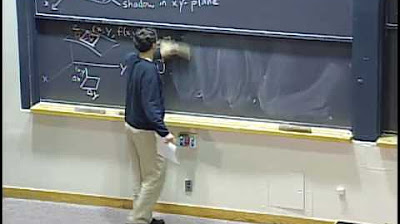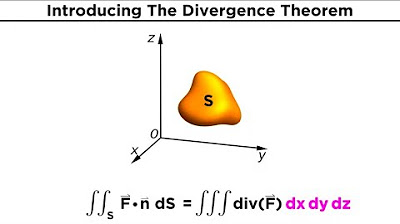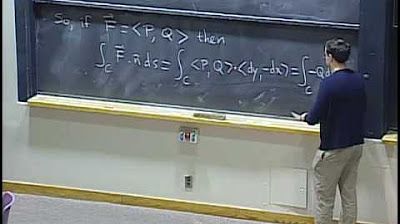Lec 29: Divergence theorem (cont.): applications & proof | MIT 18.02 Multivariable Calculus, Fall 07
TLDRThis video script delves into the divergence theorem, a fundamental concept in vector calculus that allows for the computation of flux through a closed surface by evaluating the triple integral of the divergence of a vector field within the enclosed volume. The script explains the theorem's physical interpretation, particularly in the context of incompressible fluids and source rates, and provides a detailed walkthrough of its proof for vertically simple regions. It further connects the theorem to the diffusion equation, illustrating how it governs the spread of substances like smoke in air or temperature distribution in solids, offering a comprehensive understanding of both mathematical formulation and real-world applications.
Takeaways
- 📚 The script discusses the Divergence Theorem, which is a method to calculate the flux of a vector field through a closed surface by integrating the divergence of the vector field over a volume.
- 📐 The Divergence Theorem can be applied to various geometrical surfaces, and the setup for the double integral depends on the surface's geometry.
- 🔍 The del (nabla) notation is introduced as a symbolic operator for the gradient, divergence, and curl, which are first-order differential operators.
- 🧭 Divergence is the rate at which a vector field is expanding or contracting at a given point, and it is represented as the dot product of del and a vector field.
- 🌊 The physical interpretation of divergence relates to the source rate in fluid dynamics, indicating the amount of flux generated per unit volume, such as incompressible fluids like water.
- 🔄 The script differentiates between divergence and gradient, emphasizing that while both are first-order differential operators, they operate in opposite directions (gradient from functions to vectors, divergence from vectors to functions).
- 📉 The proof of the Divergence Theorem is outlined, starting with simplifying assumptions for a vector field with only a z-component and then extending to more complex scenarios.
- 🔍 The proof involves setting up triple integrals for the volume enclosed by a surface and comparing it to the flux integral over the surface, ultimately showing their equivalence.
- 📝 The script explains the process of proving the theorem for vertically simple regions and then extends the proof to more complex regions by dividing them into simpler pieces.
- 🌡 The Diffusion Equation, also known as the Heat Equation, is introduced as a partial differential equation that describes how substances or heat spread out in a medium over time.
- 🔧 The script connects the Divergence Theorem to the physical understanding of diffusion and heat transfer, showing how mathematical concepts can model real-world phenomena.
Q & A
What is the divergence theorem and how does it relate to the flux of a vector field?
-The divergence theorem provides a way to compute the flux of a vector field through a closed surface. It states that the flux of a vector field F through a closed surface S, which bounds a region D, can be calculated either by a double integral over the surface or, if the vector field is defined everywhere inside, by a triple integral of the divergence of F over the volume of D.
What is the physical interpretation of the divergence of a vector field?
-The divergence of a vector field corresponds to the source rate, which represents the amount of flux generated per unit volume. It measures the amount of sources or sinks per unit volume in a given place, indicating how much stuff is being produced or consumed at each point in space.
How is the del notation used in the context of the divergence theorem?
-The del notation, often pronounced as 'del', is a symbolic notation for an operator used in vector calculus. It is used to represent the operation of taking the derivative in the direction of the components of a vector. For instance, the divergence of a vector field F can be represented as del dot F, which mathematically is the sum of partial derivatives of the components of F with respect to their corresponding spatial variables.
What is the relationship between the gradient, divergence, and curl in vector calculus?
-The gradient, divergence, and curl are all first-order differential operators in vector calculus. The gradient of a scalar function results in a vector field, the divergence of a vector field results in a scalar function, and the curl of a vector field results in another vector field. They are related in that they all involve first partial derivatives but operate on different types of quantities and produce different types of results.
Can you explain the proof of the divergence theorem using the concept of a vertically simple region?
-The proof of the divergence theorem for a vertically simple region involves setting up a triple integral over the region where the integration is first done over the z variable, with bounds determined by the top and bottom faces of the region. The flux through the top and bottom faces is calculated using the normal vectors to these faces, and the flux through the vertical sides is shown to be zero due to the vertical nature of the vector field. The proof then equates the triple integral of the divergence of the vector field with the flux integral over the surface, thus proving the theorem for this special case.
How does the divergence theorem relate to the physical concept of diffusion?
-The divergence theorem is fundamental to understanding diffusion. It can be used to calculate how substances, like smoke or dye, spread out in a fluid over time. The theorem helps to relate the rate of change of concentration at a point to the flow of the substance, which is governed by the concentration gradients.
What is the diffusion equation and how does it relate to the heat equation?
-The diffusion equation describes how the concentration of a substance diffuses over time in a medium. It is also known as the heat equation because it governs the distribution of heat in a solid or fluid at rest. The equation relates the rate of change of the concentration or temperature at a point to the Laplacian of the concentration or temperature, which is a measure of how much the value at a point differs from the average value of its neighbors.
How is the Laplacian operator defined in the context of the diffusion equation?
-The Laplacian operator, denoted as del squared or ∇², is defined as the divergence of the gradient of a scalar field. In the context of the diffusion equation, it is represented as the sum of the second partial derivatives of the scalar field (concentration or temperature) with respect to each spatial coordinate, i.e., ∂²u/∂x² + ∂²u/∂y² + ∂²u/∂z².
What is the significance of the constant 'k' in the diffusion equation?
-The constant 'k' in the diffusion equation is a proportionality constant that relates the rate of change of concentration or temperature to the spatial distribution of the quantity being diffused. It represents the diffusion coefficient or thermal diffusivity, which depends on the properties of the medium and the substance being diffused.
Can you provide an example of how the divergence theorem might be applied in physics?
-An example of the divergence theorem in physics is in fluid dynamics, where it can be used to analyze the flow of an incompressible fluid. By applying the theorem, one can determine the net flow of fluid through a surface by calculating the divergence of the velocity field within a volume, which is crucial for understanding phenomena like vorticity and circulation.
Outlines
📚 Introduction to the Divergence Theorem
The paragraph introduces the Divergence Theorem, which is a method for calculating the flux of a vector field through a closed surface. It explains that the theorem allows for the computation of flux using either a double integral over the surface or a triple integral over the volume enclosed by the surface of the divergence of the vector field. The paragraph also introduces the del operator and its symbolic representation, which is used in the notation for divergence. The physical interpretation of the divergence theorem is hinted at but not fully explained, setting the stage for further discussion.
🌀 Physical Interpretation of Divergence
This section delves into the physical meaning of divergence, relating it to the concept of source rate in a vector field, which represents the amount of flux generated per unit volume. Using the analogy of an incompressible fluid, like water, the explanation clarifies that the divergence theorem can be understood as the balance between the flux exiting and entering a region, which must be sourced from somewhere within the region. The importance of the normal vector orientation in relation to the surface is also highlighted, emphasizing that the flux is measured as the difference between outgoing and incoming flows.
📘 Divergence vs. Gradient Clarification
The paragraph clarifies the difference between divergence and gradient, two first-order differential operators. It emphasizes that while both operators involve first partial derivatives, they serve different purposes: the gradient maps a scalar function to a vector field, whereas divergence maps a vector field to a scalar function. The importance of careful notation when using these operators is stressed to avoid confusion. The discussion also touches on the physical implications of divergence in vector fields, such as in rotating flows where divergence is zero.
📖 Proof Strategy for the Divergence Theorem
The script outlines the proof strategy for the Divergence Theorem, starting with a simplification by considering a vector field with only a z-component. It proposes to prove the theorem for a 'vertically simple' region, which allows for an easy setup of the integral over the z variable. The paragraph explains the process of setting up the triple integral for such a region and hints at the steps that will be taken to generalize the proof for more complex regions and vector fields with multiple components.
📐 Setting Up the Triple Integral for a Vertically Simple Region
This section describes the process of setting up a triple integral for a vector field with a z-component over a vertically simple region, which is bounded by two functions in the z-direction. The paragraph explains how to define the bounds for the z-integration and how to express the triple integral in terms of a double integral over the projection of the region onto the xy-plane. The explanation includes the computation of the inner integral and how it relates to the function defining the top face of the region.
🔍 Computing Flux Through the Surface
The focus shifts to computing the flux of the vector field through the surface of the region, which includes the top, bottom, and sides. The paragraph explains how to set up the flux integral for each part of the surface, considering the orientation of the normal vectors and the contributions of the z-component of the vector field. It also discusses the simplification that occurs because the vector field is vertical, leading to zero flux through the sides of the region.
📚 Generalizing the Proof for Non-Vertically Simple Regions
The script discusses how to extend the proof of the Divergence Theorem to regions that are not vertically simple. It suggests cutting the region into simpler pieces that are easier to integrate over and then summing the results. The paragraph also explains how the flux through the cuts introduced during the division of the region will cancel out due to opposite orientations, leading to a valid proof for the general case.
🌡️ The Diffusion Equation and Its Physical Significance
This section introduces the diffusion equation, which governs the spread of substances like smoke in air or the distribution of heat in a medium. The equation is presented as a partial differential equation relating the change in concentration over time to the Laplacian of the concentration function. The paragraph also explains the physical basis of the equation, connecting it to the movement of molecules and the process of diffusion or heat transfer.
🚀 Deriving the Diffusion Equation Using the Divergence Theorem
The script concludes with a derivation of the diffusion equation using the Divergence Theorem. It describes the relationship between the flow of a substance, represented by a vector field, and the concentration gradient. The flow is assumed to be proportional to the negative gradient of the concentration, leading to a relationship between the flow and the rate of change of concentration over time. The Divergence Theorem is then used to connect the flux of the flow through a region to the change in total concentration within that region, ultimately leading to the diffusion equation.
Mindmap
Keywords
💡Divergence Theorem
💡Vector Field
💡Flux
💡Triple Integral
💡Divergence
💡Del Notation
💡Incompressible Fluid
💡Diffusion Equation
💡Laplace's Equation
💡Gradient
Highlights
Introduction of the divergence theorem and its application in computing the flux of a vector field through a closed surface.
Explanation of how to set up a double integral for flux using the geometry of a surface and the vector field.
Reduction of the flux calculation to a triple integral of the divergence of the vector field within a volume.
Introduction of del notation as a symbolic operator for partial derivatives in vector calculus.
Discussion on the physical interpretation of divergence as a source rate or the amount of flux generated per unit volume.
Comparison of divergence with the gradient, emphasizing they are distinct first-order differential operators.
Proof strategy for the divergence theorem using simplifications and the method similar to Green's theorem.
Detailed proof for a vector field with only a z-component in a vertically simple region.
Generalization of the proof to include vector fields with x and y components by summing individual cases.
Handling of non-vertically simple regions by dividing them into simpler pieces for the application of the theorem.
Physical significance of the divergence theorem in understanding empirical equations related to force fields like electric fields.
Introduction to the diffusion equation and its relation to the spreading of substances in a fluid.
Explanation of the diffusion equation as a partial differential equation relating the concentration's change over time to its spatial distribution.
Connection of the diffusion equation to the heat equation, showing how it governs temperature distribution in a non-moving fluid or solid.
Derivation of the diffusion equation using the physical concept of flow from high to low concentration regions and the divergence theorem.
Final derivation showing that the change in concentration over time is proportional to the Laplacian of the concentration function.
Transcripts
Browse More Related Video

Lec 28: Divergence theorem | MIT 18.02 Multivariable Calculus, Fall 2007

Divergence theorem proof (part 1) | Divergence theorem | Multivariable Calculus | Khan Academy

The Divergence Theorem

Tensor Calculus Lecture 13b: Integration - The Divergence Theorem

Lec 23: Flux; normal form of Green's theorem | MIT 18.02 Multivariable Calculus, Fall 2007

2D divergence theorem | Line integrals and Green's theorem | Multivariable Calculus | Khan Academy
5.0 / 5 (0 votes)
Thanks for rating: